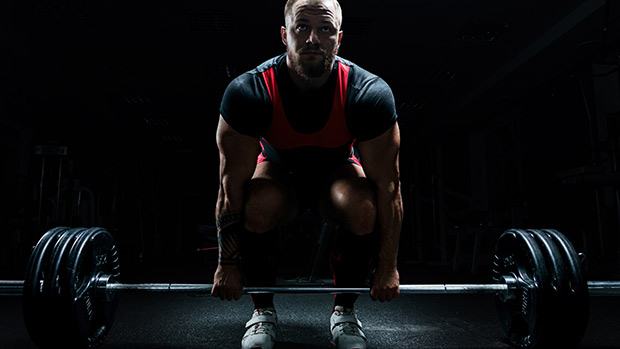If you're a strength athlete – especially a powerlifter, CrossFitter, or strongman competitor – you must have a huge deadlift. And if you want to actually do well, you'll need grip strength that's out of this world.
I've helped two of the strongest men in Canada with their deadlifts: Jean-François Caron (1000 pound deadlift) and Jimmy Paquet (900+ pound deadlift). World's Strongest Man, Martin Licis, used my strength-skill/giant cluster approach to boost his deadlift. (He even gave me credit in a video. Thanks, big man!)
I also train a few world-class powerlifters, including a female who just did a triple with 418 pounds (190kg) on the deadlift at under 154 pounds (70kg) of bodyweight.
Of course they were strong all over, but their phenomenal deadlift numbers would've never been achieved without a powerful grip. You can be incredibly strong, but if your grip is lagging, your deadlift will too.
If you can deadlift a lot more with straps than without, increasing your grip strength will push your deadlift numbers up quite a bit. Grip is the number one strength leak in the deadlift. (Number two is the lats, number three is the core.)
The method below was created by one of the most spectacular deadlifters of all time, a man who deadlifted 730 pounds (330kg) with one hand and 840 pounds (380kg) with the traditional mixed grip.
And those lifts were achieved in the 1920s, decades before steroids were invented, 15 years before testosterone was first synthesized, and without any supportive lifting gear.
That man was Hermann Görner.
This is the ultimate finger and grip strength training method. Nothing comes close to it. It'll benefit ANYONE requiring finger and grip strength: powerlifters, MMA fighters, CrossFit competitors, throwers, football players, baseball players (for hitting), and rock climbers. Heck, even baseball pitchers and golfers would benefit from stronger fingers.
The method is actually very simple. The Görner ramp is a variation of what I call a "continuous ramp."
In a continuous ramp, you gradually work up to your maximum weight for a certain number of reps (for instance, 3 reps per set). When you hit your max, you switch to a second variation of this same movement, but one in which you can handle more weight.
You start where you finished the first variant and you continue to ramp up the weight from set to set. Ideally, you want to take jumps that'll allow you to get at least 3-4 sets of each variant.
The Görner ramp is comprised of four deadlift variations:
1. Single-Finger Deadlift
Use your regular deadlift technique but use only the index finger of each hand (double "overhand" grip). Start extremely light. A client of mine with a 700 pound deadlift could only work up to 135 pounds x 3 the first time he tried it! And remember, you want 3-4 sets, at least.
2. Two-Finger Deadlift
Now use your index and middle finger of each hand to deadlift. This is still going to be extremely challenging. My 700-pound deadlifter only did 205 x 3 the first time he tried it. But here's a goal for you: Görner did 600 pounds (270kg)!
3. Three-Finger Deadlift
Use your index, middle, and ring fingers to hold the bar, still with a double overhand grip. This should allow you to use more weight. I expect you to be able to use around 50-60% of what you'd do with your regular grip. If you can take that up to 70-80%, your grip will no longer be a strength leak.
4. Double Overhand Deadlift
This is your regular deadlift but where you use a double overhand grip (both hands pronated). This is much weaker than the mixed/over-under grip because the bar will roll more easily, opening your hands up. As such, you'll need a lot more grip strength to hold on.
The goal is to get 3-4 gradually heavier sets for each step. Note that the jumps between sets will be much smaller with steps number 1 and 2 (maybe 10 pounds per set) and much larger in the last two steps.
Here's what it could look like:
Single Finger
- Bar x 10
- 95 pounds x 3
- 105 pounds x 3
- 115 pounds x 3
- 125 pounds x 3
Two Fingers
- 135 pounds x 3
- 155 pounds x 3
- 175 pounds x 3
- 195 pounds x 3
Three Fingers
- 205 pounds x 3
- 235 pounds x 3
- 265 pounds x 3
- 295 pounds x 3 (not all jumps need to be the same)
Double Overhand
- 335 pounds x 3
- 375 pounds x 3
- 405 pounds x 3
Grip strength is mostly neurological. As such, it'll improve rapidly, so don't freak out if your numbers are really low at first.
Being mostly neurological also means that it's best to use lower reps. I like to stay at 5 reps or fewer in this progression.
The two cycles that I like the most are:
Double Wave
- Week 1: Ramp to 5RM
- Week 2: Ramp to 4RM
- Week 3: Ramp to 3RM
- Week 4: Ramp to 2RM
- Week 5: Ramp to 1RM
- Week 6: Ramp to 5RM
- Week 7: Ramp to 4RM
- Week 8: Ramp to 3RM
- Week 9: Ramp to 2RM
- Week 10: Ramp to 1RM
Single Wave
- Week 1: Ramp to 5RM
- Week 2: Ramp to 5RM
- Week 3: Ramp to 4RM
- Week 4: Ramp to 4RM
- Week 5: Ramp to 3RM
- Week 6: Ramp to 3RM
- Week 7: Ramp to 2RM
- Week 8: Ramp to 2RM
- Week 9: Ramp to 1RM
- Week 10: Ramp to 1RM
When you do the Görner ramp in a workout, you don't use any other deadlifting in that session. You can do assistance exercises for the deadlift, but not the deadlift itself.
What you'll find is that this ramp is much more fatiguing on the lower back and core than regular deadlifting. If you tried to deadlift after that ramp your performance would be horrible.
What we do is have a second deadlift workout in the week where we train the deadlift itself. In fact, my powerlifting clients deadlift three days a week. In that set-up...
- Monday we use the Görner ramp.
- Wednesday is an easier "technique" session where we add pauses during the lift.
- Friday (or Saturday depending on recovery capacities) is the heavy deadlift workout.
If you choose to only do two deadlift sessions per week, do the Görner ramp Monday and the heavy deadlifting Friday.
Why not just train the deadlift normally and add grip work?
I'm all for extra grip work! I have many clients do grip work. For example, the powerlifters I work with will do pinch-grip deadlift holds, the farmer's walk, or fat bar holds. I also do a lot of Captains of Crush gripper work. But the Görner ramp trumps them all for increasing the deadlift. Here's why:
1. It's more specific
Grip strength is affected by body position and tension in other muscles. So the closer you can get to your deadlift positions when training your grip, the easier it is to transfer the new grip strength to the deadlift itself.
2. You get more technique work on the deadlift
Granted, the weights will be much lower than in your normal deadlift. But you'll quickly find that if you get out of position, it gets harder for your grip. This will teach you the most economical and efficient bar path and will help you engrain it.
3. It makes the homunculus work for you
What is the homunculus? It's your brain's visual representation of the importance of each part of your body. It looks like this:

The bigger a body part is on the homunculus, the more "space" it has in your brain, or the more information it sends to your brain. As you can see, the hands are huge. They send more information to your brain than any other body part.
A negative/uncomfortable sensation for your hands can completely mess up the quality of a movement. That's why it's so hard to have a golfer change his grip on the club. A CrossFitter will also perform poorly when his or her hands are sore.
What does that have to do with the Görner ramp? Well, you get used to deadlifting while your hands are struggling. Overtime you get used to it. An uncomfortable situation now becomes comfortable. That means deadlifting with your normal grip will feel even more stable and strong.
You don't have to use the full Görner ramp in its own workout to benefit from Görner's genius. Here are two of my favorite alternative ways to use this approach.
1. Görner Warm-Up
You can use 1-2 steps of the Görner ramp to warm-up/get activated for your deadlift workout. This is not unlike what Canadian National Olympic lifting coach Pierre Roy used to do with female lifters: they'd warm-up with a man's bar (which is 3mm thicker) and switch to the women's bar for their work sets. When your hands have to work harder, it amps up the nervous system rapidly (remember the homunculus).
You could warm-up with 2 sets of two-finger deadlifts and 2-3 sets of three-finger deadlifts, then start your regular deadlift session. Just be careful not to do too much because if challenging your hands is good to activate the nervous system, it can quickly overload it too. And you don't want to fatigue your hands before heavy deadlifting either.
2. Görner Assistance
If grip strength is one of your deadlift problem areas, but you don't want to devote a whole workout to the Görner ramp, you could pick one of the first three steps and do 3-4 work sets of 3-5 reps AFTER your deadlift as an assistance exercise.
One way I like to use this approach is to progress through the three steps in three-week waves.
- Weeks 1-3: Single-finger deadlift
- Weeks 4-6: Two-finger deadlift
- Weeks 7-9: Three-finger deadlift
Regardless of how you use it, it's a very effective training approach. You'll find it very humbling at first because you'll use super light weights, but your strength will increase quickly. The rewards far outweigh the initial ego crush.





